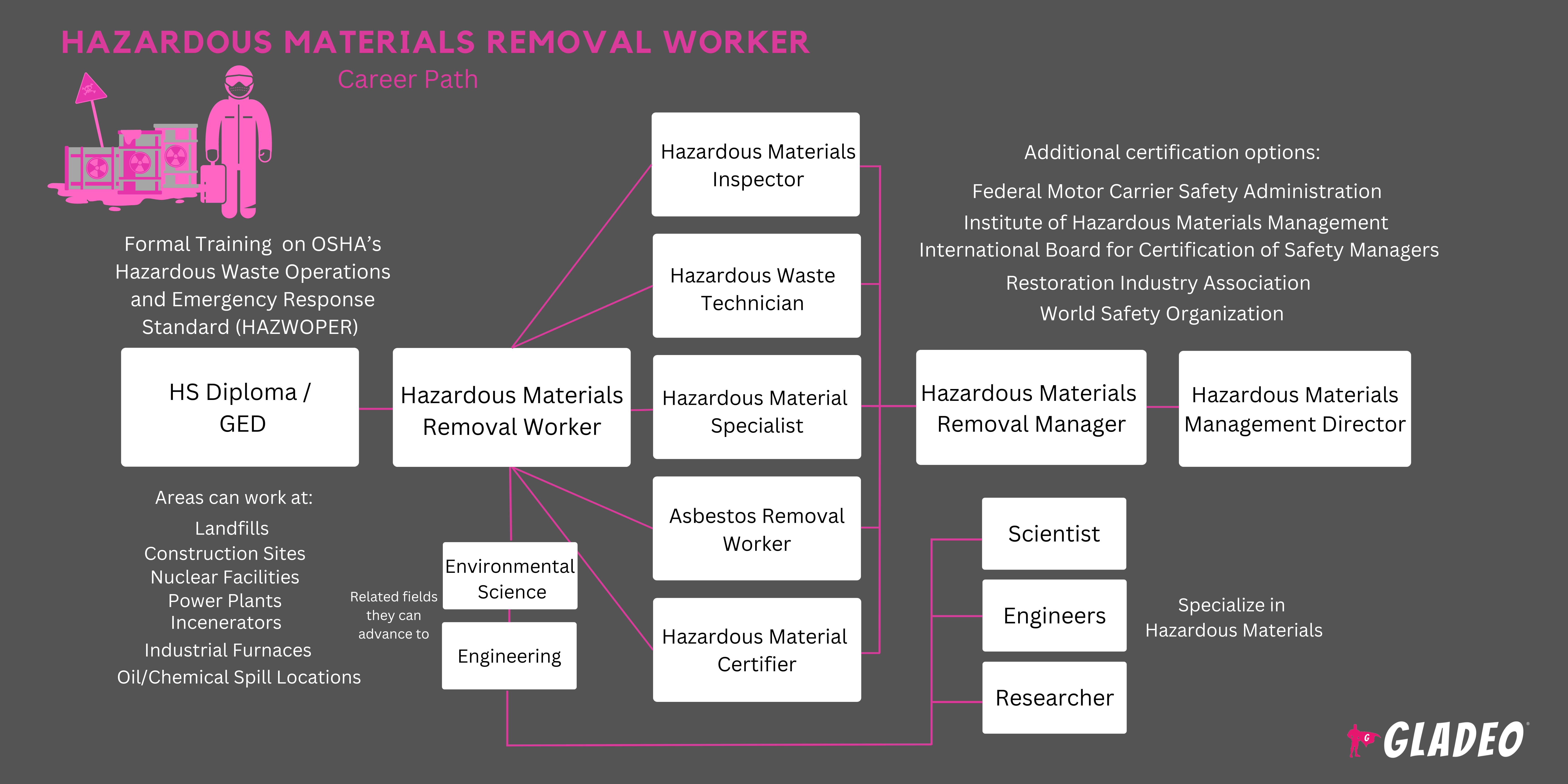Spotlights
Hazardous Materials Technician, Hazmat Removal Specialist, Environmental Remediation Technician, Asbestos Abatement Worker, Lead Abatement Worker, Mold Remediation Specialist, Hazardous Waste Removal Technician, Biohazard Cleanup Technician, Industrial Hygiene Technician, Decontamination Specialist
Modern society has generated an exorbitant range of hazardous materials which we have to contend with. From asbestos in walls to spilled fuels, lead-based paints, and radioactive waste in nuclear power plants, there’s no shortage of extremely toxic substances that must be carefully removed and safely disposed of. It’s the job of specially-trained Hazardous Materials (aka Hazmat) Removal Workers to come in, clean up, and get rid of these dangerous materials before people, animals, or the environment are exposed to them. In some cases, they must first neutralize the most harmful aspects of the materials prior to taking them away.
Depending on the materials they’re working with, Hazmat Materials Removal Workers must wear personal protective equipment such as whole-body garments (“hazmat suits”), gloves, facial shields, and respirators or self-contained breathing apparatus. They generally work in crews, following step-by-step protocols to minimize the risk of exposure or contamination.
There are numerous state and federal laws that must be complied with when packaging, shipping, storing, or disposing of such dangerous substances, including rules set forth by the Environmental Protection Agency. Meanwhile, employers must ensure their Hazmat crews are protected to the greatest extent possible, in accordance with Occupational Safety and Health Administration regulations. It’s a dangerous job that can require working in confined spaces, at great heights, or in inclement weather conditions, but Hazmat workers receive ample training and guidance to act safely as they work to protect the rest of us from harmful materials.
- Removing harmful, toxic materials from buildings, worksites, or accident scenes
- Helping to safeguard the public, wildlife, and the environment
- Learning how to properly remove hazardous waste, which may be a useful foundation for additional career opportunities
Lịch làm việc
Work schedules and environments vary depending on a Hazmat worker’s area of specialization (i.e. lead paint, asbestos, fuel or oil spills, radioactive materials, explosives, flammable gasses, etc.). Some may work predominantly outdoors and may be on call to respond to emergency situations. Working nights, weekends, holidays, and overtime is not uncommon.
Nhiệm vụ tiêu biểu
- Assess work environment to determine appropriate levels of personal protective equipment
- Determine if particle respirators or self-contained breathing apparatus are needed
- Plan out procedures for safely entering, cleaning, and removing hazardous materials
- Prepare containment areas prior to starting work
- Build scaffolding, if necessary to reach materials
- Test hazardous substances using monitoring devices and neutralize them as needed before attempting cleanup
- Measure and track radiation levels when working around irradiated materials
- Use detergents, chemicals, sandblasters, or other cleaning tools to decontaminate and clean all affected areas to include equipment, tools, or other items that need to be kept
- Use appropriate tools to remove harmful materials such as asbestos or lead
- Pack, remove, load, transport, and store or otherwise dispose of hazardous waste materials in accordance with applicable state and federal laws
- Use lifting equipment like hoists or forklifts to lift pallets and other heavy objects and load them onto vehicles
- Respond to routine and emergency cleanups
- Remove mold and contaminated materials that cannot be salvaged
- Clearly label and keep close track of all waste to be removed
- Maintain thorough documentation of where the materials are moved
- Follow suitable disposal methods to ensure the inappropriate waste matter is not dumped in landfills or in bodies of water
- Encase hazardous materials in concrete when necessary
- Prepare suitable materials for bioremediation
- Recycle materials as warranted
- Dispose of computer-related waste such as lead or mercury
Trách nhiệm bổ sung
- Stay on top of safety developments in the industry
- Work closely with team leaders and members to ensure the overall job and all tasks are fully understood
- Wear all appropriate protective gear and follow all applicable guidelines
- Ensure compliance with safety, ethical, and legal requirements. Raise questions if a situation doesn’t seem right
Kỹ năng mềm
- Lắng nghe tích cực
- Định hướng tuân thủ
- Phối hợp
- Tư duy phản biện
- Định hướng chi tiết
- Giám sát
- Kiên nhẫn
- Lập kế hoạch và tổ chức
- Kỹ năng giải quyết vấn đề
- Quan tâm đến an toàn
- Kỹ năng giao tiếp mạnh mẽ
- Phán đoán đúng đắn
- Làm việc theo nhóm
- Quản lý thời gian
Kỹ năng kỹ thuật
- Ability to operate hoists, forklifts, cranes, or trucks (if needed)
- Familiarity with hand tools and power tools, such as vacuums, sandblasters, filter pumps, steam cleaners, high-pressure sprayers, and concrete mixers
- Familiarity with various hazardous chemicals including solvents and cleaners
- Knowledge of buildings and construction
- Sức mạnh thể chất và sức chịu đựng
- Understanding of appropriate personal protective equipment and related gear
- Understanding of safety and emergency response protocols (such as using emergency showers and eyewash stations)
- Construction services
- Governmental and environmental agencies
- Private contractors
- Remediation and waste management services
- Waste treatment and disposal companies
Hazardous Materials Removal Workers are expected to know and follow safety procedures to mitigate risks of exposure to themselves and others. They may often be called upon to work long hours, which can lead to some workers seeking to take “shortcuts” in their procedures. However, employers are on the hook to ensure workers do their jobs correctly. The EPA and OSHA can issue citations with heavy fines for those who fail to comply, especially when there are mishaps or incidents which cause harmful exposure, injuries, or illnesses. Hazmat workers must work efficiently to meet timeframes, but also maintain strict compliance with protocols as they perform their duties.
Safe hazmat removal has long been a priority for the EPA, OSHA, and other governmental organizations, but private companies have sometimes been hit or miss when it came to doing the cleanups and disposals right. In 2021, Greens Steel reported that Texas companies had received a stunning “$5,648,881,393 in fines issued for incorrect disposal of hazardous waste over the past 5 years.”
The pressure is increasingly on such companies to commit to compliance in order to protect their workers, the public, the environment, and any wildlife that could be impacted by harmful exposures. This includes the decommissioning of nuclear power plants which must be carefully removed from service while “reducing residual radioactivity to a level that permits release of the property and termination of the operating license,” per the Nuclear Regulatory Commission.
Hazardous Materials Removal Workers may not have dreamed of entering this career field when they were younger, but chances are they enjoyed working outdoors or with their hands. They might have enjoyed participating in sports or other physical activities, as well as taking up hobbies that involved following methodical, step-by-step procedures (such as working on vehicle engines). They don’t mind wearing protective gear while they work and take suitable precautions to ensure they’re working safely when handling tools or other equipment. Chances are, they were equally happy working on their own or as a part of an organized team striving towards a common goal.
- Hazardous Materials Removal Workers must be at least 18 and need a high school diploma or GED, but don’t need a college education
- Hazmat workers learn through supervised On-the-Job training, which includes relevant safety protocols, proper wear and use of personal protective equipment, and applicable processes for safely cleaning, removing, and transporting hazardous materials
- Some Hazmat workers receive formal training on OSHA’s Hazardous Waste Operations and Emergency Response Standard (HAZWOPER) or other guidelines
- Those working with nuclear material will undergo additional training about nuclear materials and radiation safety (per the Nuclear Regulatory Commission)
- Workers will also learn how to identify hazards, test substances, select appropriate chemicals and tools to use, and operate specific equipment or vehicles, as needed
- Some related work experience, such as in construction, may help Hazmat workers learn the ropes faster
- State-issued permits or licenses are necessary to work with or transport certain waste materials, such as asbestos and lead. These permits/licenses usually require passing an exam and taking continuing classes
- Các tùy chọn chứng nhận bổ sung bao gồm:
▸ Hazardous Material Endorsement
▸ Combination of Tank Vehicle and Hazardous Materials
▸ Certified Dangerous Goods Trainer
▸ Student Certified Hazardous Materials Manager
▸ Certified Hazardous Materials Practitioner
▸ Certified Dangerous Goods Professional
▸ Certified Hazardous Materials Manager
- International Board for Certification of Safety Managers - Certified Hazard Control Manager
- Restoration Industry Association -
▸ Certified Restorer
▸ Certified Mold Professional
▸ Certified Hazardous Materials Technician
▸ Certified Hazardous Materials Supervisor
▸ Certified Safety Technician
Hazmat Removal Workers don’t need a college degree. Training is provided by employers and through applicable governmental agencies, as needed. However, those who wish to boost their resumes can take hazardous materials management and waste technology courses in college. Students can pursue certificates, an associate’s, or even a bachelor’s in hazmat management, environmental science, or related majors. But again, no degree is needed. For this career field, at most you might want to look for a certificate program at a community college or vocational/trade school. Applicable courses can usually be taken online.
- Consider applying for part-time jobs where you can learn about construction and get experience working with hand and power tools
- Pay attention during high school math and chemistry classes, and volunteer for student activities where you can learn about teamwork and project management
- Engage in a physical exercise program to develop the strength and stamina needed to work in hazmat removal
- Volunteer for construction projects in your community, such as with Habitat for Humanity
- Learn about the various types of hazmat environments and career options. Try to decide which area you want to work in
- Study job postings to see if there are good opportunities in your area that don’t require formal education or certification ahead of applying
- If needed, knock out a few hazmat-related classes or a certificate at a vocational school or community college to help boost your credentials
- Workers may need to possess a valid driver’s license, so if you don’t have one, you might want to study and take the test to get a license

- You’ll have to apply for entry-level jobs to get started in the hazmat field. Employers will usually provide all training necessary, but some might seek workers with experience or pertinent certifications such as asbestos, lead, or hazardous waste certification
- Get some practical work experience under your belt before applying, if possible. Ideally, jobs related to construction, cleaning, or working with tools and equipment will look good on an application
- Look for apprenticeship opportunities related to hazmat or construction
- Let your network know you are looking for work. Most job opportunities are actually discovered through personal connections
- Keep your social media clean and professional in case hiring managers want to vet you before making a hiring decision
- Check out job portals such as Indeed, Simply Hired, and Glassdoor, as well as Craigslist or the career pages of companies you are interested in working for
- Ask former supervisors and peers if they’ll serve as personal references
- You might not need a resume to apply, but you can still check out Hazardous Materials Removal Worker resume templates to get ideas
- Study Hazardous Materials Removal Worker interview questions to prepare for those interviews
- The day-to-day work attire for hazmat workers isn’t fancy, but dress professionally for job interviews!
- If you don’t have a driver's license, you might need one because many jobs require operating a motor vehicle
- Hazardous Materials Removal Workers can get promoted to supervisory positions if they have enough experience, do solid work, meet timeframes, comply with rules, and complete necessary training
- Advancement depends on many variables, including which area of hazmat you specialize in. Workers should finish applicable advanced certifications when the time is right. Don’t procrastinate or others could move ahead of you
- Certification options include the Federal Motor Carrier Safety Administration’s Hazardous Material Endorsement; the Institute of Hazardous Materials Management’s Certified Hazardous Materials Practitioner; and the lWorld Safety Organization’s Certified Hazardous Materials Technician. See the Education tab for more certification options
- Build trust by taking your job seriously and showing that you’re ready for more responsibility
- Talk with your supervisor about advancement paths. Let them know you’re willing to take the steps needed to move up
- Complete OSHA HAZWOPER supervisor training, when applicable
- Request to learn how to operate any tools, equipment, or vehicles that might help you advance
- State-issued permits or licenses are necessary for some roles, so obtain your permits/licenses as soon as you can
- Collaborate effectively on teams and demonstrate leadership
- Đối xử với mọi người bằng sự tôn trọng và giữ bình tĩnh dưới áp lực
- Grow your professional network by joining unions and other organizations
- Win recognition that’ll look great on your resume
Các trang web
- Bộ Năng lượng
- Sở Giao thông Vận tải
- Cơ quan bảo vệ môi trường
- Cơ quan Quản lý An toàn Vận tải Cơ giới Liên bang
- Viện Quản lý Vật liệu Nguy hiểm
- Hội đồng quốc tế chứng nhận các nhà quản lý an toàn
- Liên minh Lao động Quốc tế Bắc Mỹ
- Mine Safety and Health Administration
- Nuclear Energy Institute
- Nuclear Regulatory Commission
- Occupational Safety & Health Administration
- Restoration Industry Association
Sách vở
- Hazardous Materials Awareness and Operations, by Rob Schnepp
- Hazardous Materials Monitoring and Detection Devices, by Christopher Hawley
- Managing Hazardous Materials A Definitive Text, by Maribeth S. Bradfield PE
Being a Hazardous Materials Removal Worker means long hours, a whole lot of compliance with safety protocols, and potential exposure for harmful waste which can have long-term health effects. If you want to explore a few related occupations, the Bureau of Labor Statistics suggests the following:
- Construction Laborers and Helpers
- Firefighters
- Công nhân cách nhiệt
- Nhà máy xử lý nước và nước thải và nhà điều hành hệ thống
In addition, O*Net Online lists the below-related fields:
- Cleaners of Vehicles and Equipment
- Explosives Workers, Ordnance Handling Experts, and Blasters
- Highway Maintenance Workers
- Recycling and Reclamation Workers
- Refuse and Recyclable Material Collectors
- Septic Tank Servicers and Sewer Pipe Cleaners
Nguồn cấp tin tức

Công việc nổi bật

Các khóa học và công cụ trực tuyến

Annual Salary Expectations
New workers start around $49K. Median pay is $63K per year. Highly experienced workers can earn around $78K.
Annual Salary Expectations
New workers start around $48K. Median pay is $64K per year. Highly experienced workers can earn around $69K.






